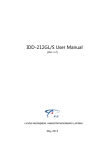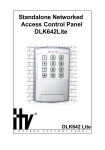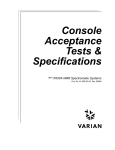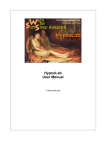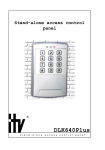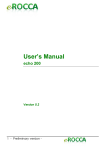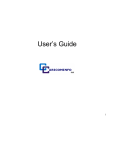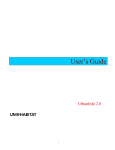Download Minimum Data Set 3.0 Resident Assessment Instrument User`s Manual
Transcript
CMS’s RAI Version 3.0 Manual CH 3: MDS Items [B] SECTION B: HEARING, SPEECH, AND VISION Intent: The intent of items in this section is to document the resident’s ability to hear (with assistive hearing devices, if they are used), understand, and communicate with others and whether the resident experiences visual limitations or difficulties related to diseases common in aged persons. B0100: Comatose Item Rationale Health-related Quality of Life • Residents who are in a coma or persistent vegetative state are at risk for the complications of immobility, including skin breakdown and joint contractures. Planning for Care • Care planning should center on eliminating or minimizing complications and providing care consistent with the resident’s health care goals. Steps for Assessment DEFINITION COMATOSE (coma) A pathological state in which neither arousal (wakefulness, alertness) nor awareness exists. The person is unresponsive and cannot be aroused; he/she does not open his/her eyes, does not speak and does not move his/her extremities on command or in response to noxious stimuli (e.g., pain). 1. Review the medical record to determine if a neurological diagnosis of comatose or persistent vegetative state has been documented by a physician, or nurse practitioner, physician assistant, or clinical nurse specialist if allowable under state licensure laws. Coding Instructions • Code 0, no: if a diagnosis of coma or persistent vegetative state is not present during the 7-day look-back period. Continue to B0200 Hearing. • Code 1, yes: if the record indicates that a physician, nurse practitioner or clinical nurse specialist has documented a diagnosis of coma or persistent vegetative state that is applicable during the 7-day look-back period. Skip to Section G0110, Activities of Daily Living (ADL) Assistance. May 2011 Page B-1 CMS’s RAI Version 3.0 Manual B0100: Comatose (cont.) Coding Tips • Only code if a diagnosis of coma or persistent vegetative state has been assigned. For example, some residents in advanced stages of progressive neurologic disorders such as Alzheimer’s disease may have severe cognitive impairment, be non-communicative and sleep a great deal of time; however, they are usually not comatose or in a persistent vegetative state, as defined here. CH 3: MDS Items [B] DEFINITION PERSISTENT VEGETATIVE STATE Sometimes residents who were comatose after an anoxic-ischemic injury (i.e., not enough oxygen to the brain) from a cardiac arrest, head trauma, or massive stroke, regain wakefulness but do not evidence any purposeful behavior or cognition. Their eyes are open, and they may grunt, yawn, pick with their fingers, and have random body movements. Neurological exam shows extensive damage to both cerebral hemispheres. B0200: Hearing Item Rationale Health-related Quality of Life • Problems with hearing can contribute to sensory deprivation, social isolation, and mood and behavior disorders. • Unaddressed communication problems related to hearing impairment can be mistaken for confusion or cognitive impairment. Planning for Care • Address reversible causes of hearing difficulty (such as cerumen impaction). • Evaluate potential benefit from hearing assistance devices. • Offer assistance to residents with hearing difficulties to avoid social isolation. May 2011 Page B-2 CMS’s RAI Version 3.0 Manual CH 3: MDS Items [B] B0200: Hearing (cont.) • Consider other communication strategies for persons with hearing loss that is not reversible or is not completely corrected with hearing devices. • Adjust environment by reducing background noise by lowering the sound volume on televisions or radios, because a noisy environment can inhibit opportunities for effective communication. Steps for Assessment 1. Ensure that the resident is using his or her normal hearing appliance if they have one. Hearing devices may not be as conventional as a hearing aid. Some residents by choice may use hearing amplifiers or a microphone and headphones as an alternative to hearing aids. Ensure the hearing appliance is operational. 2. Interview the resident and ask about hearing function in different situations (e.g. hearing staff members, talking to visitors, using telephone, watching TV, attending activities). 3. Observe the resident during your verbal interactions and when he or she interacts with others throughout the day. 4. Think through how you can best communicate with the resident. For example, you may need to speak more clearly, use a louder tone, speak more slowly or use gestures. The resident may need to see your face to understand what you are saying, or you may need to take the resident to a quieter area for them to hear you. All of these are cues that there is a hearing problem. 5. Review the medical record. 6. Consult the resident’s family, direct care staff, activities personnel, and speech or hearing specialists. Coding Instructions • Code 0, adequate: No difficulty in normal conversation, social interaction, or listening to TV. The resident hears all normal conversational speech and telephone conversation and announcements in group activities. • Code 1, minimal difficulty: Difficulty in some environments (e.g., when a person speaks softly or the setting is noisy). The resident hears speech at conversational levels but has difficulty hearing when not in quiet listening conditions or when not in one-onone situations. The resident’s hearing is adequate after environmental adjustments are made, such as reducing background noise by moving to a quiet room or by lowering the volume on television or radio. • Code 2, moderate difficulty: Speaker has to increase volume and speak distinctly. Although hearing-deficient, the resident compensates when the speaker adjusts tonal quality and speaks distinctly; or the resident can hear only when the speaker’s face is clearly visible. May 2013 Page B-3 CMS’s RAI Version 3.0 Manual CH 3: MDS Items [B] B0200: Hearing (cont.) • Code 3, highly impaired: Absence of useful hearing. The resident hears only some sounds and frequently fails to respond even when the speaker adjusts tonal quality, speaks distinctly, or is positioned face-to-face. There is no comprehension of conversational speech, even when the speaker makes maximum adjustments. Coding Tips for Special Populations • Residents who are unable to respond to a standard hearing assessment due to cognitive impairment will require alternate assessment methods. The resident can be observed in their normal environment. Does he or she respond (e.g., turn his or her head) when a noise is made at a normal level? Does the resident seem to respond only to specific noise in a quiet environment? Assess whether the resident responds only to loud noise or do they not respond at all. B0300: Hearing Aid Item Rationale Health-related Quality of Life • Problems with hearing can contribute to social isolation and mood and behavior disorders. • Many residents with impaired hearing could benefit from hearing aids or other hearing appliances. • Many residents who own hearing aids do not have the hearing aids with them or have nonfunctioning hearing aids upon arrival. Planning for Care • Knowing if a hearing aid was used when determining hearing ability allows better identification of evaluation and management needs. • For residents with hearing aids, use and maintenance should be included in care planning. • Residents who do not have adequate hearing without a hearing aid should be asked about history of hearing aid use. • Residents who do not have adequate hearing despite wearing a hearing aid might benefit from a re-evaluation of the device or assessment for new causes of hearing impairment. Steps for Assessment 1. Prior to beginning the hearing assessment, ask the resident if he or she owns a hearing aid or other hearing appliance and, if so, whether it is at the nursing home. 2. If the resident cannot respond, write the question down and allow the resident to read it. May 2013 Page B-4 CMS’s RAI Version 3.0 Manual CH 3: MDS Items [B] B0300: Hearing Aid (cont.) 3. If the resident is still unable, check with family and care staff about hearing aid or other hearing appliances. 4. Check the medical record for evidence that the resident had a hearing appliance in place when hearing ability was recorded. 5. Ask staff and significant others whether the resident was using a hearing appliance when they observed hearing ability (above). Coding Instructions • Code 0, no: if the resident did not use a hearing aid (or other hearing appliance) for the 7-day hearing assessment coded in B0200, Hearing. • Code 1, yes: if the resident did use a hearing aid (or other hearing appliance) for the hearing assessment coded in B0200, Hearing. B0600: Speech Clarity Item Rationale Health-related Quality of Life DEFINITION SPEECH The verbal expression of articulate words. • Unclear speech or absent speech can hinder communication and be very frustrating to an individual. • Unclear speech or absent speech can result in physical and psychosocial needs not being met and can contribute to depression and social isolation. Planning for Care • If speech is absent or is not clear enough for the resident to make needs known, other methods of communication should be explored. • Lack of speech clarity or ability to speak should not be mistaken for cognitive impairment. Steps for Assessment 1. Listen to the resident. 2. Ask primary assigned caregivers about the resident’s speech pattern. 3. Review the medical record. May 2011 Page B-5 CMS’s RAI Version 3.0 Manual CH 3: MDS Items [B] B0600: Speech Clarity (cont.) Determine the quality of the resident’s speech, not the content or appropriateness—just words spoken. 4. Coding Instructions • Code 0, clear speech: if the resident usually utters distinct, intelligible words. • Code 1, unclear speech: if the resident usually utters slurred or mumbled words. • Code 2, no speech: if there is an absence of spoken words. B0700: Makes Self Understood Item Rationale Health-related Quality of Life • Problems making self understood can be very frustrating for the resident and can contribute to social isolation and mood and behavior disorders. • Unaddressed communication problems can be inappropriately mistaken for confusion or cognitive impairment. Planning for Care • Ability to make self understood can be optimized by not rushing the resident, breaking longer questions into parts and waiting for reply, and maintaining eye contact (if appropriate). • If a resident has difficulty making self understood: — Identify the underlying cause or causes. — Identify the best methods to facilitate communication for that resident. May 2011 DEFINITION MAKES SELF UNDERSTOOD Able to express or communicate requests, needs, opinions, and to conduct social conversation in his or her primary language, whether in speech, writing, sign language, gestures, or a combination of these. Deficits in the ability to make one’s self understood (expressive communication deficits) can include reduced voice volume and difficulty in producing sounds, or difficulty in finding the right word, making sentences, writing, and/or gesturing. Page B-6 CMS’s RAI Version 3.0 Manual CH 3: MDS Items [B] B0700: Makes Self Understood (cont.) Steps for Assessment 1. Assess using the resident’s preferred language. 2. Interact with the resident. Be sure he or she can hear you or have access to his or her preferred method for communication. If the resident seems unable to communicate, offer alternatives such as writing, pointing or using cue cards. 3. Observe his or her interactions with others in different settings and circumstances. 4. Consult with the primary nurse assistant (over all shifts), if available, the resident’s family, and speech-language pathologist. Coding Instructions • Code 0, understood: if the resident expresses requests and ideas clearly. • Code 1, usually understood: if the resident has difficulty communicating some words or finishing thoughts but is able if prompted or given time. He or she may have delayed responses or may require some prompting to make self understood. • Code 2, sometimes understood: if the resident has limited ability but is able to express concrete requests regarding at least basic needs (e.g., food, drink, sleep, toilet). • Code 3, rarely or never understood: if, at best, the resident’s understanding is limited to staff interpretation of highly individual, resident-specific sounds or body language (e.g., indicated presence of pain or need to toilet). B0800: Ability to Understand Others Item Rationale Health-related Quality of Life • Inability to understand direct person-to-person communication — Can severely limit association with others. — Can inhibit the individual’s ability to follow instructions that can affect health and safety. May 2011 Page B-7 CMS’s RAI Version 3.0 Manual CH 3: MDS Items [B] B0800: Ability to Understand Others (cont.) Planning for Care • • Thorough assessment to determine underlying cause or causes is critical in order to develop a care plan to address the individual’s specific deficits and needs. Every effort should be made by the facility to provide information to the resident in a consistent manner that he or she understands based on an individualized assessment. Steps for Assessment DEFINITION ABILITY TO UNDERSTAND OTHERS Comprehension of direct person-to-person communication whether spoken, written, or in sign language or Braille. Includes the resident’s ability to process and understand language. Deficits in one’s ability to understand (receptive communication deficits) can involve declines in hearing, comprehension (spoken or written) or recognition of facial expressions. 1. Assess in the resident’s preferred language. 2. If the resident uses a hearing aid, hearing device or other communications enhancement device, the resident should use that device during the evaluation of the resident’s understanding of person-to-person communication. 3. Interact with the resident and observe his or her understanding of other’s communication. 4. Consult with direct care staff over all shifts, if possible, the resident’s family, and speechlanguage pathologist (if involved in care). 5. Review the medical record for indications of how well the resident understands others. Coding Instructions • Code 0, understands: if the resident clearly comprehends the message(s) and demonstrates comprehension by words or actions/behaviors. • Code 1, usually understands: if the resident misses some part or intent of the message but comprehends most of it. The resident may have periodic difficulties integrating information but generally demonstrates comprehension by responding in words or actions. • Code 2, sometimes understands: if the resident demonstrates frequent difficulties integrating information, and responds adequately only to simple and direct questions or instructions. When staff rephrase or simplify the message(s) and/or use gestures, the resident’s comprehension is enhanced. • Code 3, rarely/never understands: if the resident demonstrates very limited ability to understand communication. Or, if staff have difficulty determining whether or not the resident comprehends messages, based on verbal and nonverbal responses. Or, the resident can hear sounds but does not understand messages. May 2011 Page B-8 CMS’s RAI Version 3.0 Manual CH 3: MDS Items [B] B1000: Vision Item Rationale Health-related Quality of Life DEFINITION ADEQUATE LIGHT Lighting that is sufficient or comfortable for a person with normal vision to see fine detail. • A person’s reading vision often diminishes over time. • If uncorrected, vision impairment can limit the enjoyment of everyday activities such as reading newspapers, books or correspondence, and maintaining and enjoying hobbies and other activities. It also limits the ability to manage personal business, such as reading and signing consent forms. • Moderate, high or severe impairment can contribute to sensory deprivation, social isolation, and depressed mood. Planning for Care • Reversible causes of vision impairment should be sought. • Consider whether simple environmental changes such as better lighting or magnifiers would improve ability to see. • Consider large print reading materials for persons with impaired vision. • For residents with moderate, high, or severe impairment, consider alternative ways of providing access to content of desired reading materials or hobbies. Steps for Assessment 1. Ask direct care staff over all shifts if possible about the resident’s usual vision patterns during the 7-day look-back period (e.g., is the resident able to see newsprint, menus, greeting cards?). 2. Then ask the resident about his or her visual abilities. 3. Test the accuracy of your findings: • Ensure that the resident’s customary visual appliance for close vision is in place (e.g., eyeglasses, magnifying glass). • Ensure adequate lighting. May 2011 Page B-9 CMS’s RAI Version 3.0 Manual CH 3: MDS Items [B] B1000: Vision (cont.) • Ask the resident to look at regular-size print in a book or newspaper. Then ask the resident to read aloud, starting with larger headlines and ending with the finest, smallest print. If the resident is unable to read a newspaper, provide material with larger print, such as a flyer or large textbook. • When the resident is unable to read out loud (e.g. due to aphasia, illiteracy), you should test this by another means such as, but not limited to: — Substituting numbers or pictures for words that are displayed in the appropriate print size (regular-size print in a book or newspaper) Coding Instructions • Code 0, adequate: if the resident sees fine detail, including regular print in newspapers/books. • Code 1, impaired: if the resident sees large print, but not regular print in newspapers/books. • Code 2, moderately impaired: if the resident has limited vision and is not able to see newspaper headlines but can identify objects in his or her environment. • Code 3, highly impaired: if the resident’s ability to identify objects in his or her environment is in question, but the resident’s eye movements appear to be following objects (especially people walking by). • Code 4, severely impaired: if the resident has no vision, sees only light, colors or shapes, or does not appear to follow objects with eyes. Coding Tips and Special Populations • Some residents have never learned to read or are unable to read English. In such cases, ask the resident to read numbers, such as dates or page numbers, or to name items in small pictures. Be sure to display this information in two sizes (equivalent to regular and large print). • If the resident is unable to communicate or follow your directions for testing vision, observe the resident’s eye movements to see if his or her eyes seem to follow movement of objects or people. These gross measures of visual acuity may assist you in assessing whether or not the resident has any visual ability. For residents who appear to do this, code 3, highly impaired. B1200: Corrective Lenses May 2011 Page B-10 CMS’s RAI Version 3.0 Manual CH 3: MDS Items [B] B1200: Corrective Lenses (cont.) Item Rationale Health-related Quality of Life • Decreased ability to see can limit the enjoyment of everyday activities and can contribute to social isolation and mood and behavior disorders. • Many residents who do not have corrective lenses could benefit from them, and others have corrective lenses that are not sufficient. • Many persons who benefit from and own visual aids do not have them on arrival at the nursing home. Planning for Care • Knowing if corrective lenses were used when determining ability to see allows better identification of evaluation and management needs. • Residents with eyeglasses or other visual appliances should be assisted in accessing them. Use and maintenance should be included in care planning. • Residents who do not have adequate vision without eyeglasses or other visual appliances should be asked about history of corrective lens use. • Residents who do not have adequate vision, despite using a visual appliance, might benefit from a re-evaluation of the appliance or assessment for new causes of vision impairment. Steps for Assessment 1. Prior to beginning the assessment, ask the resident whether he or she uses eyeglasses or other vision aids and whether the eyeglasses or vision aids are at the nursing home. Visual aids do not include surgical lens implants. 2. If the resident cannot respond, check with family and care staff about the resident’s use of vision aids during the 7-day look-back period. 3. Observe whether the resident used eyeglasses or other vision aids during reading vision test (B1000). 4. Check the medical record for evidence that the resident used corrective lenses when ability to see was recorded. 5. Ask staff and significant others whether the resident was using corrective lenses when they observed the resident’s ability to see. May 2011 Page B-11 CMS’s RAI Version 3.0 Manual CH 3: MDS Items [B] B1200: Corrective Lenses (cont.) Coding Instructions • Code 0, no: if the resident did not use eyeglasses or other vision aid during the B1000, Vision assessment. • Code 1, yes: if corrective lenses or other visual aids were used when visual ability was assessed in completing B1000, Vision. May 2011 Page B-12














